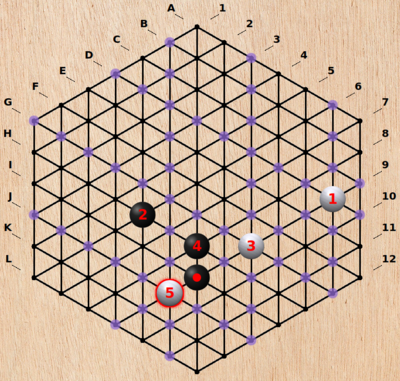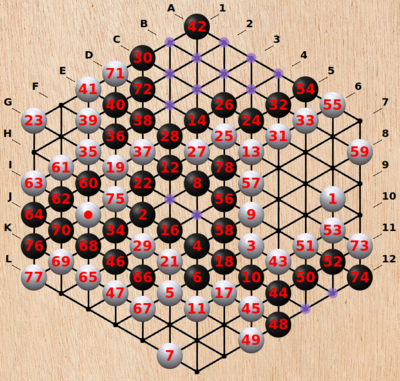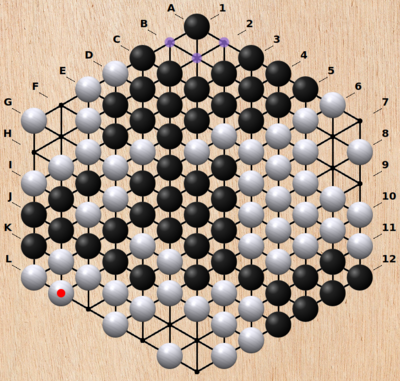Draft:Meridians (game)
| Submission declined on 30 January 2024 by TheBritinator (talk). This draft's references do not show that the subject qualifies for a Wikipedia article. In summary, the draft needs multiple published sources that are:
Where to get help
How to improve a draft
You can also browse Wikipedia:Featured articles and Wikipedia:Good articles to find examples of Wikipedia's best writing on topics similar to your proposed article. Improving your odds of a speedy review To improve your odds of a faster review, tag your draft with relevant WikiProject tags using the button below. This will let reviewers know a new draft has been submitted in their area of interest. For instance, if you wrote about a female astronomer, you would want to add the Biography, Astronomy, and Women scientists tags. Editor resources
|  |
 Comment: articles should be based on what reliable independent sources say....I'm not seeing any here? Theroadislong (talk) 15:13, 30 January 2024 (UTC)
Comment: articles should be based on what reliable independent sources say....I'm not seeing any here? Theroadislong (talk) 15:13, 30 January 2024 (UTC)
 Comment: Initially, there were 5 independent gaming platforms mentioned in the article which all have information about Meridians. Unfortunately, the whole section was deleted by user Jikybebna before the review started RolfSander (talk) 15:25, 30 January 2024 (UTC)
Comment: Initially, there were 5 independent gaming platforms mentioned in the article which all have information about Meridians. Unfortunately, the whole section was deleted by user Jikybebna before the review started RolfSander (talk) 15:25, 30 January 2024 (UTC)
| This is a draft article. It is a work in progress open to editing by anyone. Please ensure core content policies are met before publishing it as a live Wikipedia article. Find sources: Google (books · news · scholar · free images · WP refs) · FENS · JSTOR · TWL Last edited by RolfSander (talk | contribs) 3 months ago. (Update)
Finished drafting? or |
| Publishers | Kanare Abstract |
|---|---|
| Years active | 2021–present |
| Genres | Board game Abstract strategy game Perfect information |
| Players | 2 |
Meridians is an abstract strategy game with perfect information. It is a territorial game which uses the line of sight mechanics.[1]. The game is played by two players on an irregular hexagonal board. The standard lengths of the edges are 7, 7, 6, 7, 7 and 6.
Rules
Definitions
- Group: One or more stones of the same color which are adjacent to each other.
- Path: One or more empty points on an uninterrupted straight line that have a pair of same-colored stones on both ends, which are not part of the same group.
- Dead group: A group in which none of the stones is next to a path.
Gameplay
- White plays first, then alternate turns. Passing is not allowed.
- The first move of each player can be placed on any empty point.
- The second move of each player is placed such that there is a path between their two stones.
- Starting with the third move, the players perform the following actions:
- Remove all opponent’s dead groups.
- Place a stone that is adjacent to a friendly stone or that has a path to a friendly stone.
- A player who has no stones on the board loses the game.
- To compensate for the first player's advantage, the pie rule can be used. The first player places one stone of each color and the second player decides which color to play. Play then continues with White playing their second move.
Example game
To illustrate the game, an example is shown below.
- Figure 1
The first moves (1 at D9 and 2 at H6) were placed according to the pie rule. To compensate for the advantage of starting the game, the White stone has been placed further away from the center of the board. Next, White played move 3 at G9, creating a path at F9,E9 between the stones at D9 and G9. Black played move 4 at H8, also creating a path between their stones. The last move of Black (indicated with a red dot) separates the White stones 3 and 5. While 3 still has a path to 1, but the White stone 5 is now a dead group (as indicated by the red halo). In their next turn, White has the option to rescue the dead group before Black can remove it. Points on which White can play next are indicated with violet shading.
- Figure 2
White saved their stone 5 by playing move 7 at L11. After 79 moves, White has 6 groups: The three single stones at B8, G1 and L11, and the three groups surrounding the single stones. Black has only two groups: A single stone at A1 and a big group. In this position, there are no points left that can be occupied by both players. Now both players have to start filling their own territories, as passing is not allowed.
- Figure 3
After move 101, Black has to play. Whatever Black chooses, the next move will connect the single Black stone with the big black group. After that, Black has no path anymore, and White can remove all Black stones and win the game.
History
Meridians was invented 2021 by Kanare Kato [2]. The name is based on the meridians system. Meridians won the "Best combinatorial 2-player game of 2021" in the BoardGameGeek abstract games forum [3]
References
- ^ Kato, Kanare (2022) Meridians -A game of paths and path-groups. Abstract Games issue 23, C&K Publishing, pp.28-33.
- ^ "Kanare Abstract".
- ^ "Board Game Geek".


